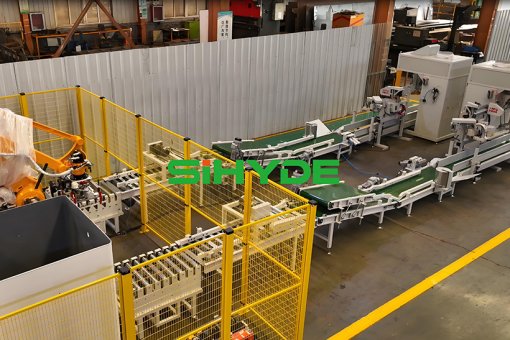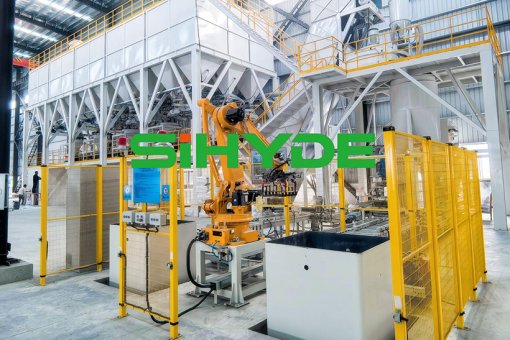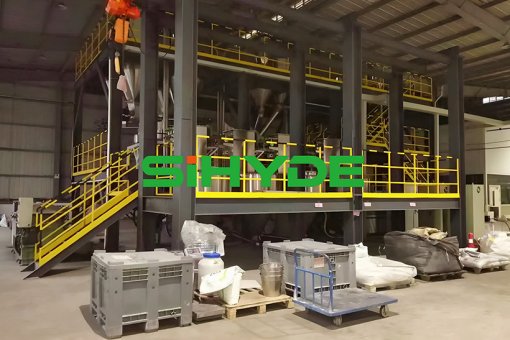Unshaped refractory batching production line
Product introduction: (PLX8-50) Design and manufacture multi-bin batching and multi-mixer automated batching production lines according to customer needs, including accurate weighing of materials with different characteristics such as aggregates and powders, with a weighing accuracy of ≤0.5%, meeting the production capacity of 1000-5000T/year. Including production lines such as castables, plastics, ramming materials, injection materials, and refractory mud.
Product features:
1. For special powder processing, a unique method is formed.
2. Measuring accuracy 0.5%
3. Dust-proof and dust-free processing.
4. Equipped with various forms of mixing equipment.
5. Equipped with robot intelligent equipment for sorting and storage.
Product Description:
Unshaped refractory materials are a type of refractory materials made of a mixture of granular and powdered refractory materials, binders, and additives. They are used directly without molding and firing, so they are also called loose refractory materials. Compared with refractory bricks, unshaped refractory materials have the characteristics of simple process, energy saving, low cost, and easy mechanized construction. On some thermal equipment, the use effect is better than refractory bricks.
There are many ways to classify unshaped refractory materials, which can be classified according to raw material materials, process characteristics and binder types. According to the raw material material, it can be divided into siliceous, clay, high alumina, magnesium, dolomite, chromium, etc. According to the process characteristics, it can be divided into castables, plastics, ramming materials, injection materials, projection materials, refractory mud, refractory coatings, dry mixes, etc. There are also many types of binders, such as various cements, inorganic salts (such as water glass, sulfates, phosphates, etc.) and organic matter (such as tar asphalt, phenolic resin, etc.).
According to the national standard GB/T4513.1-2015, the classification principles of monolithic refractory materials include product type and construction method, main raw materials and chemical composition type, bonding form and classification temperature. Product types and construction methods include refractory castables, ordinary castables, deflocculation castables, etc. The bonding form can be hydration bonding, ceramic bonding, chemical bonding or organic bonding. According to the size of the porosity, monolithic refractory materials can be divided into two categories: dense materials and thermal insulation materials.
Monolithic refractory materials are widely used in the lining of thermal equipment, such as heat treatment furnaces, ore roasting furnaces, catalytic cracking furnaces, converters, etc. Their use not only improves production efficiency and product quality, but also reduces operating costs, helping enterprises to maintain their advantages in market competition.
The automatic batching production line for monolithic refractory materials is an automated system for the production of monolithic refractory materials. This production line mainly includes a feeding system, a raw material storage system, an automatic weighing batching system, a material conveying, a mixing system, a packaging system, a dust removal system, and an electrical control and software system. It is suitable for the production of various unshaped refractory materials, such as castables, etc.
The main features of this production line include:
1. High degree of automation: The entire production process from raw material input to finished product output is automated, reducing manual intervention and improving production efficiency and product quality stability.
2. High-precision batching: The batching accuracy is as high as 0.2%-0.5%, ensuring the consistency and stability of product quality.
3. Information management: The whole process control system is adopted, combined with the latest information technology, to realize the functions of production raw material management, production plan management, production formula management, etc.
4. Environmental protection and labor environment improvement: Equipped with a dust removal system, it ensures the cleanliness and dust-freeness of the production environment and improves working conditions.
5. Flexible design: It can be differentiated according to the user's site layout and specific requirements to meet the needs of different customers.
This production line not only improves production efficiency and product quality, but also reduces operating costs, which helps enterprises maintain their advantages in market competition.


















